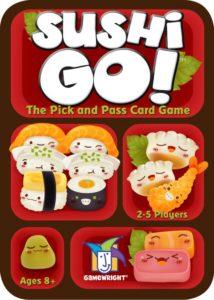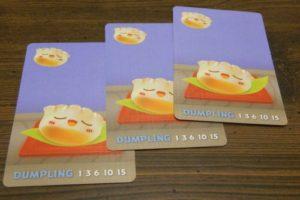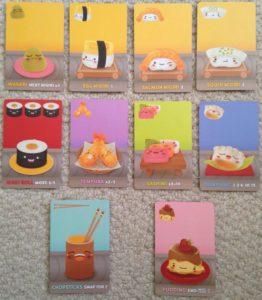
Sushi Go’s hand-passing mechanic is a good case study of how party games mellow out competitiveness to make the game more fun for everyone.
Sushi Go! is a fast-paced multiplayer (multilateral competition) card game for ages 8+. It was created by Phil Walker-Harding. Mechanically, the game is about collecting combinations of cards to score the most points. Sushi Go’s flagship mechanical twist is that after each turn, players pass their hand to the player on their left, meaning your hand is unpredictable turn-to-turn. Moreover, the card you play influences the hand you pass to the next player, so players are simultaneously motivated to a) maximize their own points by playing the best combos and b) minimize their opponents’ points by ruining their combos.
In terms of the types of fun in the MDA framework, Sushi Go offers fun via challenge and fellowship (which collectively create dominance) which makes sense in the “casual party games” genre, where players seek a scripted, simple activity that acts as a social mediator. Sushi Go fulfills this need well. Though it is a game about challenge, the mechanic of hand switching makes the game unpredictable enough that it can’t become overly competitive. Stated differently, a factor of randomness diffuses a competitive tension that might spoil the game’s competing desire of creating a comfortable social dynamic for players. It’s a casual game.
Though it is a game about challenge, the mechanic of hand switching makes the game unpredictable enough that it can’t become overly competitive.
Sushi Go’s graphic design, which is fairly cute and whimsical, reinforces the casual nature of the game. After all, you can only take yourself so seriously while playing an anthropomorphized sushi game. Therefore, in spirit, Sushi Go is not unique from other casual party card games like Exploding Kittens and Unstable Unicorns, which also boast whimsical premises with competitive gameplay that is mellowed by randomness. That said, Sushi Go does offer the hand-passing mechanic which makes the gameplay faster than its competitors and makes the relationship between players more important (since the cards you play directly impact which cards your opponents will have left). This mechanic also deftly prevents abuse; since players are able to directly impact each other’s hands at every point in the game, no one player can abuse a single strategy for long. In other words, Sushi Go solves abuse by giving players lots of ability to disrupt opponents’ strategies.
 Someone’s abusing the dumpling strategy? Play dumplings yourself to block their plans.
Someone’s abusing the dumpling strategy? Play dumplings yourself to block their plans.
My one qualm with Sushi Go is that it doesn’t scale well for more players. The game is most fun with three players (the minimum required) since, at a small group size, you can observe and play around your opponent’s strategies. When players are interacting with each other in this way, Sushi Go shines. However, as the group size increases, it becomes harder to track each person’s strategies and strategies get muddled, at which point the game feels more like players playing with themselves rather than a group playing with/against each other. This might be fixed by making the game’s combos simpler or slowing down gameplay to give players time to strategize, which are notes we’ll keep in mind when designing our game.
 Here are all the cards in the base game. With this many combinations, strategies get hard to track at larger group sizes.
Here are all the cards in the base game. With this many combinations, strategies get hard to track at larger group sizes.


